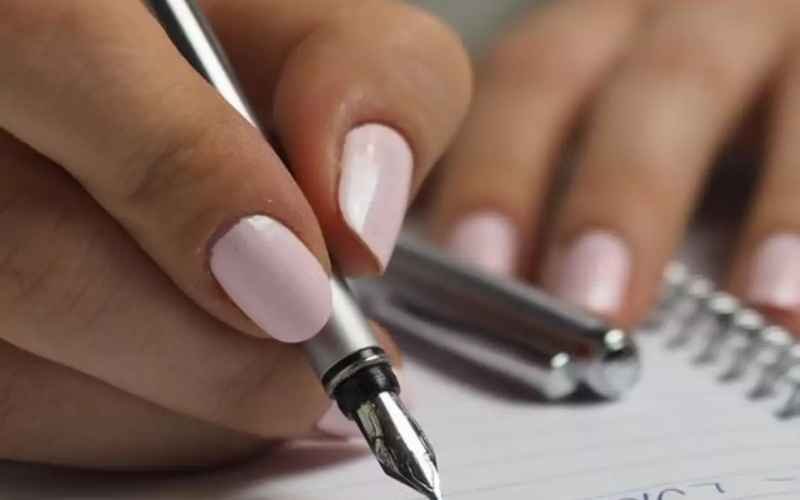Have you ever thought about how the way you hold a pen could reveal aspects of your personality? This simple action, which we often take for granted, can actually provide insights into our behavior, mindset, and even our emotions. Intrigued?

Let’s delve into this fascinating topic and see what your pen-holding style says about you.
1. The Overhand Grip
Description:
The overhand grip is a distinctive way of holding a pen, where your thumb and fingers wrap over the top of the pen. This grip may feel unconventional compared to more common grips, but it provides unique control and stability for those who use it.
Personality Traits:
1. Creative:
People who use the overhand grip often possess a unique way of thinking and a vivid imagination. This grip is indicative of someone who enjoys exploring new ideas and approaches. They may excel in artistic or innovative fields, using their creativity to come up with original solutions and concepts. Their imaginative nature allows them to see the world from different perspectives, making them adept at storytelling, design, and other creative endeavors.
2. Non-Conformist:
Those who adopt the overhand grip tend to challenge norms and are not afraid to stand out from the crowd. They have a rebellious streak and are comfortable going against the grain. This non-conformist attitude can lead them to question established practices and seek better ways of doing things. They are often trailblazers in their fields, setting trends rather than following them. Their willingness to defy conventions can inspire others to think outside the box and embrace change.
3. Independent:
Individuals who favor the overhand grip value their freedom and prefer to carve their own path. They are self-reliant and confident in their abilities to navigate life’s challenges on their own terms. Independence is a core aspect of their identity, and they thrive in environments where they have the autonomy to make their own decisions. This trait makes them natural leaders, as they are not afraid to take charge and pursue their goals with determination. Their independent spirit often drives them to pursue unique careers and lifestyles that align with their personal values and aspirations.
2. The Underhand Grip
Description:
The underhand grip involves holding the pen with your thumb and fingers wrapped underneath the pen. This grip provides stability and control, allowing for precise movements when writing or drawing.
Personality Traits:
1. Analytical:
Individuals who use the underhand grip typically have a strong attention to detail and enjoy solving problems logically. They excel in tasks that require careful analysis and critical thinking. Their analytical mindset allows them to break down complex issues into manageable components, making them valuable in professions such as engineering, science, finance, and research. They are methodical in their approach and prefer to rely on facts and data rather than intuition.
2. Organized:
Keeping things in order is crucial for those who favor the underhand grip. They thrive in structured environments where they can plan and execute tasks efficiently. Organization helps them maintain clarity and focus, allowing them to achieve their goals with precision. They often excel in roles that require meticulous planning and adherence to timelines, such as project management, administration, and logistics. Their ability to maintain order enhances productivity and fosters a sense of reliability among their peers.
3. Dependable:
People who use the underhand grip are known for their consistency and thoroughness in their work. They take pride in delivering high-quality results and can be relied upon to meet expectations. Dependability is a hallmark of their personality, as they prioritize reliability and integrity in all aspects of their professional and personal lives. Their commitment to excellence makes them valuable team members and trusted collaborators. They are often sought after for roles where reliability and attention to detail are paramount, such as in healthcare, education, and legal professions.
3. The Thumb Wrap
Description:
The thumb wrap grip involves wrapping your thumb around the pen, often covering your index finger partially or completely. This grip provides stability and control, allowing for a firm grasp while writing or drawing.
Personality Traits:
1. Practical:
Individuals who use the thumb wrap grip are typically grounded and prefer straightforward, realistic approaches to challenges. They have a practical mindset that values tangible results and practical solutions over theoretical or abstract ideas. Their practicality enables them to assess situations objectively and find effective ways to achieve goals. They excel in roles that require hands-on problem-solving and the ability to apply practical knowledge, such as in engineering, trades, and technical fields.
2. Sensible:
Making decisions based on practicality and common sense is important to those who favor the thumb wrap grip. They approach problems and opportunities with a rational mindset, weighing the pros and cons before taking action. Their sensible nature helps them navigate uncertainty and complexity with clarity and composure. They are adept at balancing risks and rewards, ensuring that their choices align with their long-term goals and values.
3. Reliable:
People who use the thumb wrap grip are often perceived as trustworthy and steady. They prioritize consistency and reliability in their actions, earning the respect and confidence of others. Their reliability extends beyond their work ethic to their interpersonal relationships, where they are known for their loyalty and dependability. They are valued team members who contribute to a stable and harmonious work environment. Their commitment to delivering results with integrity makes them reliable partners in both professional and personal settings.
4. The Tripod Grip
Description:
The tripod grip involves holding the pen with your thumb, index finger, and middle finger, forming a tripod-like structure. This grip is widely recognized as a standard and efficient way to hold writing utensils, providing stability and control.
Personality Traits:
1. Balanced:
Individuals who use the tripod grip often exhibit a harmonious blend of creativity and logic. They can seamlessly integrate innovative ideas with practical solutions, striking a balance between imagination and rationality. Their ability to see the big picture while paying attention to details allows them to approach tasks with a holistic perspective. This balanced approach enables them to excel in diverse fields where both creative thinking and analytical skills are valued, such as marketing, design, and education.
2. Adaptable:
The tripod grip users are adaptable and versatile, capable of switching between different tasks and roles effortlessly. They thrive in dynamic environments where they can apply their skills and knowledge to tackle various challenges. Their adaptability allows them to adjust to changing circumstances with agility and resilience, making them valuable assets in fast-paced industries. They are quick learners who embrace new opportunities and strive for continuous improvement in their personal and professional endeavors.
3. Sociable:
People who favor the tripod grip often enjoy interacting with others and are perceived as friendly and approachable. They have excellent interpersonal skills that enable them to build meaningful connections and collaborate effectively with diverse teams. Their sociable nature fosters a positive work environment where communication flows freely and ideas are openly exchanged. They excel in roles that require teamwork, leadership, and customer-facing interactions, leveraging their ability to connect with people from different backgrounds and perspectives. Their sociability enhances their influence and effectiveness in building strong professional networks and partnerships.
5. The Four-Finger Grip
Description:
The four-finger grip involves using all four fingers (index, middle, ring, and pinky) to hold the pen, with the thumb typically resting against the side of the pen. This grip provides a stable and controlled hold, allowing for precise movements during writing or drawing.
Personality Traits:
1. Detail-Oriented:
Individuals who use the four-finger grip are often highly detail-oriented. They pay meticulous attention to even the smallest aspects of their work, ensuring accuracy and completeness. Their keen eye for detail allows them to spot inconsistencies and errors that others might overlook, making them valuable in professions that require precision, such as accounting, editing, and scientific research. They take pride in producing thorough and polished outcomes that reflect their commitment to excellence.
2. Perfectionist:
Having high standards and striving for excellence is characteristic of those who favor the four-finger grip. They have a perfectionist mindset that drives them to achieve flawless results in everything they do. They are not easily satisfied with mediocrity and continually push themselves to improve and refine their skills. Their pursuit of perfection motivates them to set ambitious goals and pursue them with determination and persistence. While their perfectionism can lead to meticulous work, it also encourages continuous growth and development.
3. Hardworking:
People who use the four-finger grip are known for their diligence and work ethic. They are willing to put in the effort and time needed to accomplish their goals, demonstrating a strong commitment to their tasks and responsibilities. Their hardworking nature enables them to persevere through challenges and setbacks, maintaining focus and productivity. They take pride in their accomplishments, knowing that their dedication has contributed to their success. Their reliability and perseverance make them trusted team members and leaders who lead by example in achieving results through hard work and dedication.
Conclusion
The way you hold a pen might seem trivial, but it can offer a glimpse into your personality. Whether you’re creative, analytical, practical, balanced, or detail-oriented, your pen grip reveals unique aspects of who you are. Next time you pick up a pen, take a moment to consider what it might be saying about you.
So, how do you hold your pen, and does the description resonate with your personality? Share your thoughts in the comments below!
FAQs
1. What does it mean if I hold my pen with an overhand grip?
The overhand grip typically indicates a creative and non-conformist personality. People who hold their pen this way often have a vivid imagination and enjoy thinking outside the box. This grip suggests a preference for freedom and an independent spirit, valuing uniqueness over conformity in their approach to tasks.
2. How does the underhand grip reflect my personality?
The underhand grip suggests an analytical and organized personality. Those who hold their pen this way tend to be detail-oriented, preferring structured and logical approaches to problem-solving. They are often reliable and consistent in their work, focusing on accuracy and thoroughness.
3. What personality traits are associated with the thumb wrap pen grip?
The thumb wrap grip indicates a practical and sensible personality. Individuals who use this grip prefer practical solutions and rely on common sense in decision-making. They are often seen as reliable and steady, choosing straightforward and realistic approaches to tasks.
4. What does it mean if I naturally use the tripod grip for writing?
Using the tripod grip suggests a balanced and adaptable personality. People who hold their pen this way possess a blend of creativity and logic, easily switching between tasks and roles. They are sociable and approachable, enjoying interactions with others while maintaining a harmonious approach to challenges.
5. Is there any significance to using a four-finger grip for writing?
The four-finger grip indicates a detail-oriented and perfectionist personality. Those who hold their pen with all four fingers tend to pay close attention to details and strive for excellence in their work. They are diligent and hardworking, setting high standards for themselves and consistently aiming for precision.
6. Can my pen-holding style change over time?
Yes, pen-holding styles can evolve depending on various factors such as changes in writing habits, ergonomic considerations, or personal preferences. While core personality traits may remain consistent, the way you hold a pen can adapt with practice, comfort, or necessity.
7. How does stress or mood affect my pen-holding grip?
Stress or mood can influence your pen-holding grip. For example, heightened stress levels might lead to a tighter grip or more erratic pen-holding habits. Conversely, a relaxed or focused mood may result in a more natural and fluid pen grip, reflecting your state of mind in that moment.
8. Are there cultural or regional differences in pen-holding styles?
Yes, cultural or regional factors can influence pen-holding styles. Different educational systems, writing traditions, or ergonomic considerations may shape how individuals hold pens across various cultures. Observing pen-holding habits can offer insights into cultural norms and personal backgrounds.
9. Can my pen-holding style impact my handwriting or signature?
Yes, your pen-holding style can influence your handwriting and signature. The way you grip the pen affects the pressure, angle, and fluidity of your writing movements. Consistent pen-holding habits contribute to the development of your unique handwriting style and signature characteristics.
10. How can I determine my natural pen-holding style?
To determine your natural pen-holding style, observe how you naturally grip a pen when writing or drawing. Notice the position of your thumb, fingers, and overall grip on the pen. Your natural pen-holding style reflects your comfort and ease in handling a pen during everyday writing tasks.
11. Can children’s pen-holding styles indicate future personality traits?
Children’s pen-holding styles can provide early indicators of developing personality traits. For example, creative children may explore unconventional pen grips, while detail-oriented children might exhibit more structured pen-holding habits. Monitoring children’s pen grips can offer insights into their evolving personalities.
12. Are there health considerations related to pen-holding styles?
Yes, pen-holding styles can affect hand ergonomics and potentially impact hand health. Incorrect or strained pen grips may contribute to discomfort, repetitive strain injuries, or writing fatigue over time. Choosing an ergonomic pen grip that suits your comfort and writing style can promote better hand health.
13. Can left-handed individuals have different pen-holding styles from right-handed individuals?
Yes, left-handed individuals may develop different pen-holding styles compared to right-handed individuals. Left-handed grips often accommodate the natural writing direction from left to right, influencing finger placement and grip adjustments. Left-handed pen-holding styles reflect adaptations to writing preferences and handedness.
14. How does pen-holding style relate to digital writing tools?
Pen-holding styles can adapt to digital writing tools such as styluses or touchscreen pens. The transition to digital mediums may influence grip adjustments for optimal touchscreen interaction or digital drawing techniques. Digital pen grips balance precision, comfort, and technological compatibility in digital writing contexts.
15. Can pen-holding styles be modified for better handwriting?
Yes, modifying pen-holding styles can improve handwriting techniques. Adjusting grip pressure, finger placement, or wrist alignment can enhance writing fluidity, legibility, and comfort. Practicing ergonomic pen grips and mindful writing techniques contribute to developing clearer and more consistent handwriting.
16. How can I teach proper pen-holding techniques to children or beginners?
Teaching proper pen-holding techniques involves demonstrating ergonomic grips, finger positions, and wrist alignments. Encouraging comfortable and natural pen grips supports handwriting development and reduces writing strain. Providing interactive exercises and feedback helps children or beginners adopt effective pen-holding habits.
17. Are there psychological studies linking pen-holding styles to personality traits?
Psychological studies explore correlations between pen-holding styles and personality traits. Research suggests connections between grip preferences, cognitive behaviors, and individual characteristics such as creativity, analytical thinking, or emotional expression. Understanding these associations enhances insights into handwriting psychology and personality assessments.
18. Can pen-holding styles affect drawing or artistic expression?
Yes, pen-holding styles influence drawing techniques and artistic expression. Artists may adapt grips for varying pen strokes, shading effects, or detailed illustrations. Personalized pen grips support creative freedom, precision, and artistic versatility in visual arts, reflecting individual drawing styles and expressive preferences.
19. How does handwriting analysis interpret pen-holding styles?
Handwriting analysis interprets pen-holding styles as indicators of personality traits, emotional states, or cognitive behaviors. Observing grip dynamics, pressure variations, and stroke formations provides insights into handwriting characteristics and psychological profiles. Analyzing pen grips enhances handwriting assessments and personality assessments in forensic, therapeutic, or vocational contexts.
20. Can pen-holding styles influence academic or professional success?
Yes, pen-holding styles contribute to academic or professional success through efficient writing techniques, note-taking skills, and communication clarity. Developing ergonomic pen grips and effective handwriting habits supports academic achievements, professional presentations, and interpersonal communications. Optimizing pen-holding styles enhances writing productivity, cognitive performance, and career competencies.














